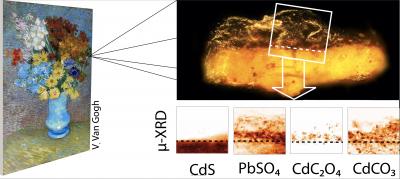Scientists have used powerful X-ray beams to find out the cause of color degradation in a Van Gogh painting. Certain parts in the "Flowers in a blue vase" painting have changed in color, which is suspected to be due to a varnish coating which had been applied for protection.
 Illustration showing where one of the two microsamples was taken in the painting (left), and an optical-microscope image of this sample (right). The overlay indicates the area of the sample being studied, and the four graphs below the concentration of the four key compounds in it which are linked to the discolouration. Credit: K. Janssens, University of Antwerp
Illustration showing where one of the two microsamples was taken in the painting (left), and an optical-microscope image of this sample (right). The overlay indicates the area of the sample being studied, and the four graphs below the concentration of the four key compounds in it which are linked to the discolouration. Credit: K. Janssens, University of Antwerp
In 1887, Vincent Van Gogh had painted the "Flowers in a blue vase" in Paris. Initially no protective varnish had been applied. In 2009, a conservation treatment revealed that some parts of the painting which had been painted with cadmium yellow paint had a grey opaque crust.
In unvarnished paintings, the cadmium sulphide in cadmium yellow paint oxidizes with air to form cadmium sulphate, leading to loss of color and luminosity. However, in the Van Gogh painting a dark, orange-grey, cracked crust was formed.
Two microscopic paint samples from the original painting were sent to the European Synchrotron Radiation Facility (ESRF) in France and to the Deutsches Elektronen-Synchrotron (DESY) in Hamburg, Germany. X-ray beams were used for the study to find out the internal structure and chemical composition at the interface between the paint and varnish. Crystalline cadmium sulphate compounds which were supposed to have been formed were not found. Sulphate anions had reacted with lead ions in the varnish to form anglesite.
The scientists suspect that a lead-based siccative in the varnish could be the source.
Further, cadmium ions and the degradation products formed a cadmium oxalate layer at the paint-varnish interface. The cadmium oxalate and anglesite together contributed to the orange-grey, opaque crust on the painting.
The results of the study are to be published in Analytical Chemistry.